高等数学中符号的读法及功能 (挺全的)
- 格式:docx
- 大小:54.41 KB
- 文档页数:6
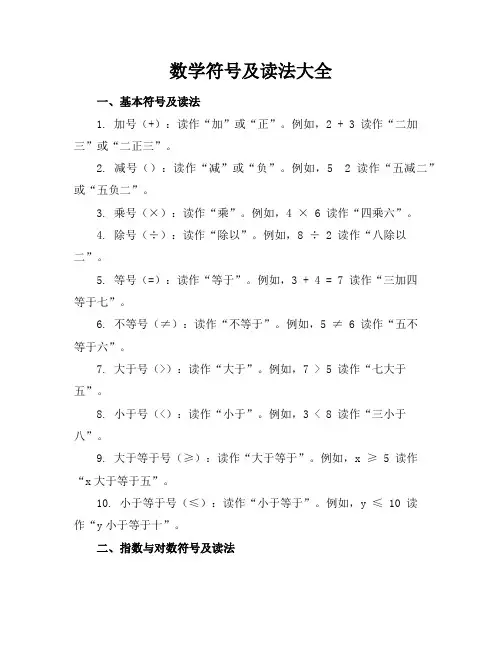
数学符号及读法大全一、基本符号及读法1. 加号(+):读作“加”或“正”。
例如,2 + 3 读作“二加三”或“二正三”。
2. 减号():读作“减”或“负”。
例如,5 2 读作“五减二”或“五负二”。
3. 乘号(×):读作“乘”。
例如,4 × 6 读作“四乘六”。
4. 除号(÷):读作“除以”。
例如,8 ÷ 2 读作“八除以二”。
5. 等号(=):读作“等于”。
例如,3 + 4 = 7 读作“三加四等于七”。
6. 不等号(≠):读作“不等于”。
例如,5 ≠ 6 读作“五不等于六”。
7. 大于号(>):读作“大于”。
例如,7 > 5 读作“七大于五”。
8. 小于号(<):读作“小于”。
例如,3 < 8 读作“三小于八”。
9. 大于等于号(≥):读作“大于等于”。
例如,x ≥ 5 读作“x大于等于五”。
10. 小于等于号(≤):读作“小于等于”。
例如,y ≤ 10 读作“y小于等于十”。
二、指数与对数符号及读法1. 指数符号(^):读作“的幂”。
例如,2^3 读作“二的三次幂”。
2. 对数符号(log):读作“以为底的对数”。
例如,log₂8 读作“以二为底八的对数”。
三、集合符号及读法1. 属于符号(∈):读作“属于”。
例如,3 ∈ {1, 2, 3} 读作“三属于集合{一、二、三}”。
2. 不属于符号(∉):读作“不属于”。
例如,4 ∉ {1, 2, 3} 读作“四不属于集合{一、二、三}”。
3. 空集符号(∅):读作“空集”。
例如,∅表示一个不包含任何元素的集合。
四、几何符号及读法1. 直线符号(→):读作“直线”。
例如,AB → 表示直线AB。
2. 射线符号(⇀):读作“射线”。
例如,AC ⇀表示射线AC。
3. 线段符号(|):读作“线段”。
例如,BC | 表示线段BC。
4. 角符号(∠):读作“角”。
例如,∠ABC 表示角ABC。
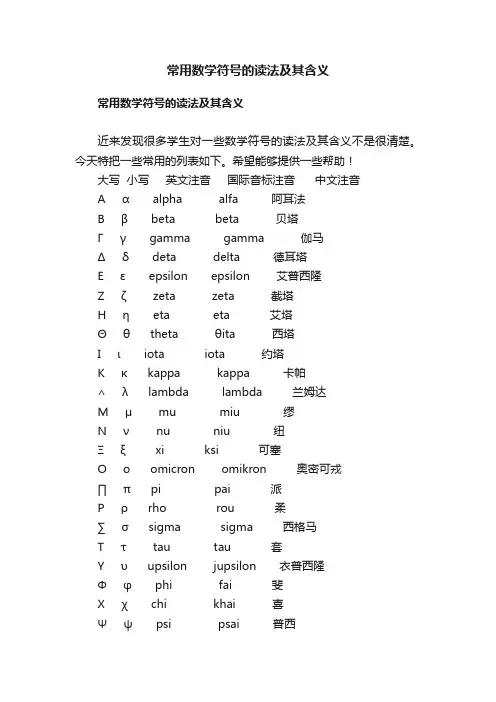
常用数学符号的读法及其含义常用数学符号的读法及其含义近来发现很多学生对一些数学符号的读法及其含义不是很清楚。
今天特把一些常用的列表如下。
希望能够提供一些帮助!大写小写英文注音国际音标注音中文注音Αα alpha alfa 阿耳法Ββ beta beta 贝塔Γγ gamma gamma 伽马Δδ deta delta 德耳塔Εε epsilon epsilon 艾普西隆Ζζ zeta zeta 截塔Ηη eta eta 艾塔Θθ theta θita西塔Ιι iota iota 约塔Κκ kappa kappa 卡帕∧λ lambda lambda 兰姆达Μμ mu miu 缪Νν nu niu 纽Ξξ xi ksi 可塞Οο omicron omikron 奥密可戎∏π pi pai 派Ρρ rho rou 柔∑σ sigma sigma 西格马Ττ tau tau 套Υυ upsilon jupsilon 衣普西隆Φφ phi fai 斐Χχ chi khai 喜Ψψ psi psai 普西Ωω omega omiga 欧米伽符号表符号含义i -1的平方根f(x) 函数f在自变量x处的值sin(x) 在自变量x处的正弦函数值exp(x) 在自变量x处的指数函数值,常被写作exa^x a的x次方;有理数x由反函数定义ln x exp x 的反函数ax 同 a^xlogba 以b为底a的对数; blogba = acos x 在自变量x处余弦函数的值tan x 其值等于 sin x/cos xcot x 余切函数的值或 cos x/sin xsec x 正割含数的值,其值等于 1/cos xcsc x 余割函数的值,其值等于 1/sin xasin x y,正弦函数反函数在x处的值,即 x = sin yacos x y,余弦函数反函数在x处的值,即 x = cos yatan x y,正切函数反函数在x处的值,即 x = tan yacot x y,余切函数反函数在x处的值,即 x = cot yasec x y,正割函数反函数在x处的值,即 x = sec yacsc x y,余割函数反函数在x处的值,即 x = csc yθ 角度的一个标准符号,不注明均指弧度,尤其用于表示atan x/y,当x、y、z用于表示空间中的点时i, j, k 分别表示x、y、z方向上的单位向量(a, b, c) 以a、b、c为元素的向量(a, b) 以a、b为元素的向量(a, b) a、b向量的点积a61b a、b向量的点积(a61b) a、b向量的点积|v| 向量v的模|x| 数x的绝对值Σ 表示求和,通常是某项指数。
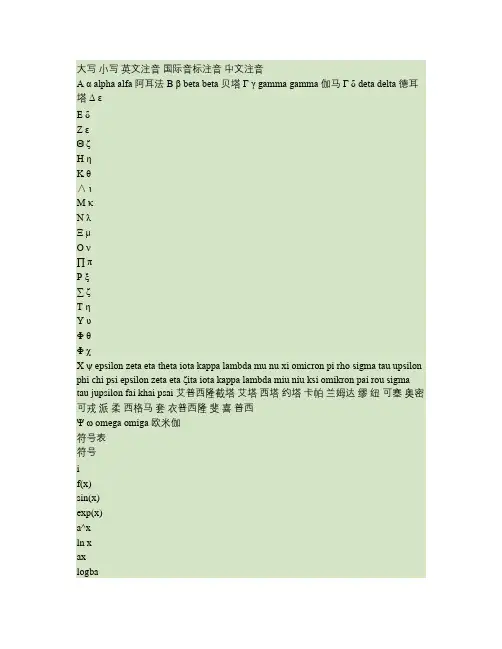
大写小写英文注音国际音标注音中文注音Α α alpha alfa 阿耳法Β β beta beta 贝塔Γ γ gamma gamma 伽马Γ δ deta delta 德耳塔Δ εΕ δΖ εΘ ζΗ ηΚ θ∧ ιΜ κΝ λΞ μΟ ν∏ πΡ ξ∑ ζΤ ηΥ υΦ θΦ χΧ ψ epsilon zeta eta theta iota kappa lambda mu nu xi omicron pi rho sigma tau upsilon phi chi psi epsilon zeta eta ζita iota kappa lambda miu niu ksi omikron pai rou sigma tau jupsilon fai khai psai 艾普西隆截塔艾塔西塔约塔卡帕兰姆达缪纽可塞奥密可戎派柔西格马套衣普西隆斐喜普西Ψ ω omega omiga 欧米伽符号表符号if(x)sin(x)exp(x)a^xln xaxlogbacos xtan xcot xsec xcsc xasin xacos xatan xacot xasec xacsc xζi, j, k(a, b, c)(a, b)(a, b)a?b(a?b)|v||x| -1的平方根函数f在自变量x处的值在自变量x处的正弦函数值在自变量x处的指数函数值,常被写作ex a的x次方;有理数x由反函数定义 exp x 的反函数同 a^x 以b为底a的对数; blogba = a 在自变量x处余弦函数的值其值等于 sin x/cos x 余切函数的值或 cos x/sin x 正割含数的值,其值等于 1/cos x 余割函数的值,其值等于 1/sin x y,正弦函数反函数在x处的值,即 x = sin y y,余弦函数反函数在x处的值,即 x = cos y y,正切函数反函数在x处的值,即 x = tan y y,余切函数反函数在x处的值,即 x = cot y y,正割函数反函数在x处的值,即 x = sec y y,余割函数反函数在x处的值,即 x = csc y 角度的一个标准符号,不注明均指弧度,尤其用于表示atan x/y,当x、y、z用于表示空间中的点时分别表示x、y、z方向上的单位向量以a、b、c为元素的向量以a、b为元素的向量 a、b 向量的点积 a、b向量的点积 a、b向量的点积向量v的模数x的绝对值表示求和,通常是某项指数。
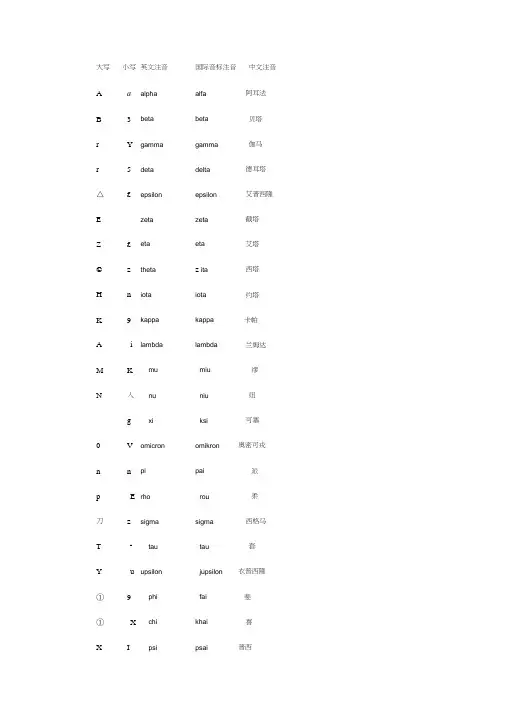
大写小写英文注音国际音标注音中文注音A a alpha alfa 阿耳法B3beta beta 贝塔r Y gamma gamma 伽马r5deta delta 德耳塔△£epsilon epsilon 艾普西隆E zeta zeta 截塔Z£eta eta 艾塔©z theta z ita 西塔H n iota iota 约塔K9kappa kappa 卡帕A i lambda lambda 兰姆达M K mu miu 缪N入nu niu 纽g xi ksi 可塞0V omicron omikron 奥密可戎n n pi pai 派p E rho rou 柔刀z sigma sigma 西格马T n tau tau 套Y u upsilon jupsilon 衣普西隆①9phi fai 斐①X chi khai 喜X I psi psai 普西omegaomiga欧米伽符号表符号含义i f(x)-1 的平方根函数f 在自变量x 处的值sin(x)在自变量x 处的正弦函数值exp(x)在自变量x 处的指数函数值,常被写作exa A x a 的x 次方;有理数x 由反函数定义ln x exp x 的反函数ax 同aAxlogba 以b 为底a 的对数;blogba = acos x 在自变量x 处余弦函数的值tan x 其值等于sin x/cos xcot x 余切函数的值或cos x/sin xsec x 正割含数的值,其值等于1/cos xcsc x 余割函数的值,其值等于1/sin xasin x y,正弦函数反函数在x处的值,即x = sin y acos x y,余弦函数反函数在x处的值,即x = cos y atan x y,正切函数反函数在x处的值,即x = tan y acot x y,余切函数反函数在x处的值,即x = cot y asec x y,正割函数反函数在x处的值,即x = sec y acsc x y,余割函数反函数在x处的值,即x = csc yZ 角度的一个标准符号,不注明均指弧度,尤其用于表示atan x/y ,当x、y、z 用于表示空间中的点时i, j, k分别表示x、y、z 方向上的单位向量(a, b, c) 以 a 、 b 、 c 为元素的向量(a, b) 以a、b 为元素的向量(a, b) a、b 向量的点积a?b a、b 向量的点积(a?b) a、b 向量的点积|v| 向量v 的模|x| 数x 的绝对值表示求和,通常是某项指数。

大写小写英文注音国际音标注音中文注音Ααalpha alfa 阿耳法Ββbeta beta 贝塔Γγgamma gamma 伽马Δδdeta delta 德耳塔Εεepsilon epsilon 艾普西隆Ζζzeta zeta 截塔Ηηeta eta 艾塔Θθtheta θita西塔Ιιiota iota 约塔Κκkappa kappa 卡帕∧λlambda lambda 兰姆达Μμmu miu 缪Ννnu niu 纽Ξξxi ksi 可塞Οοomicron omikron 奥密可戎∏πpi pai 派Ρρrho rou 柔∑σsigma sigma 西格马Ττtau tau 套Υυupsilon jupsilon 衣普西隆Φφphi fai 斐Χχchi khai 喜Ψψpsi psai 普西Ωωomega omiga 欧米伽符号表符号含义i -1的平方根f(x) 函数f在自变量x处的值sin(x) 在自变量x处的正弦函数值exp(x) 在自变量x处的指数函数值,常被写作exa^x a的x次方;有理数x由反函数定义ln x exp x 的反函数ax 同a^xlogba 以b为底a的对数;blogba = acos x 在自变量x处余弦函数的值tan x 其值等于sin x/cos xcot x 余切函数的值或cos x/sin xsec x 正割含数的值,其值等于1/cos xcsc x 余割函数的值,其值等于1/sin xasin x y,正弦函数反函数在x处的值,即x = sin y acos x y,余弦函数反函数在x处的值,即x = cos y atan x y,正切函数反函数在x处的值,即x = tan y acot x y,余切函数反函数在x处的值,即x = cot y asec x y,正割函数反函数在x处的值,即x = sec y acsc x y,余割函数反函数在x处的值,即x = csc yθ角度的一个标准符号,不注明均指弧度,尤其用于表示atan x/y,当x、y、z用于表示空间中的点时i, j, k 分别表示x、y、z方向上的单位向量(a, b, c) 以a、b、c为元素的向量(a, b) 以a、b为元素的向量(a, b) a、b向量的点积a?b a、b向量的点积(a?b) a、b向量的点积|v| 向量v的模|x| 数x的绝对值Σ表示求和,通常是某项指数。
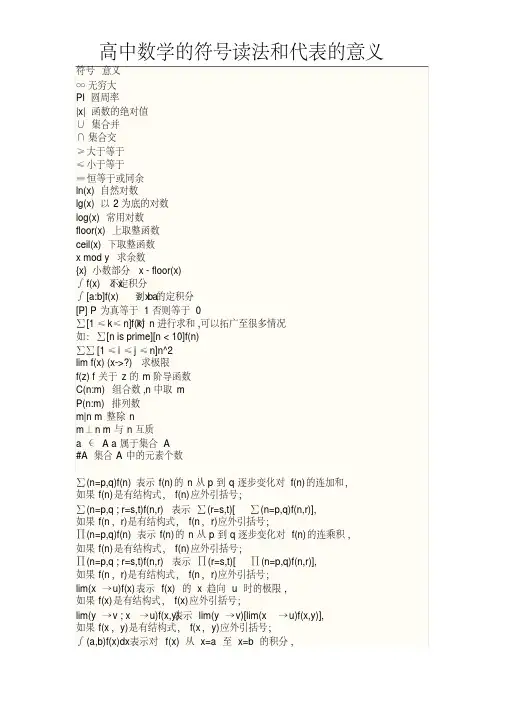
符号意义∞ 无穷大PI 圆周率|x| 函数的绝对值∪集合并∩ 集合交≥ 大于等于≤ 小于等于≡ 恒等于或同余ln(x) 自然对数lg(x) 以2为底的对数log(x) 常用对数floor(x) 上取整函数ceil(x) 下取整函数x mod y 求余数{x} 小数部分x - floor(x)∫f(x)δx不定积分到b的定积分∫[a:b]f(x)δx a[P] P为真等于1否则等于0对n进行求和,可以拓广至很多情况∑[1≤k≤n]f(k)如:∑[n is prime][n < 10]f(n)∑∑[1≤i≤j≤n]n^2lim f(x) (x->?) 求极限f(z) f关于z的m阶导函数C(n:m) 组合数,n中取mP(n:m) 排列数m|n m整除nm⊥n m与n互质a ∈ A a属于集合 A#A 集合A中的元素个数∑(n=p,q)f(n) 表示f(n)的n从p到q逐步变化对f(n)的连加和,如果f(n)是有结构式,f(n)应外引括号;∑(n=p,q ; r=s,t)f(n,r) 表示∑(r=s,t)[∑(n=p,q)f(n,r)],如果f(n,r)是有结构式,f(n,r)应外引括号;∏(n=p,q)f(n) 表示f(n)的n从p到q逐步变化对f(n)的连乘积, 如果f(n)是有结构式,f(n)应外引括号;∏(n=p,q ; r=s,t)f(n,r) 表示∏(r=s,t)[∏(n=p,q)f(n,r)],如果f(n,r)是有结构式,f(n,r)应外引括号;lim(x→u)f(x) 表示f(x) 的x 趋向u 时的极限,如果f(x)是有结构式,f(x)应外引括号;lim(y→v ; x→u)f(x,y) 表示lim(y→v)[lim(x→u)f(x,y)],如果f(x,y)是有结构式,f(x,y)应外引括号;∫(a,b)f(x)dx 表示对f(x) 从x=a 至x=b 的积分,如果f(x)是有结构式,f(x)应外引括号;∫(c,d ; a,b)f(x,y)dxdy 表示∫(c,d)[∫(a,b)f(x,y)dx]dy,如果f(x,y)是有结构式,f(x,y)应外引括号;∫(L)f(x,y)ds 表示f(x,y) 在曲线L 上的积分,如果f(x,y)是有结构式,f(x,y)应外引括号;表示f(x,y,z) 在曲面 D 上的积分,∫∫(D)f(x,y,z)dσ 如果f(x,y,z)是有结构式,f(x,y,z)应外引括号;∮(L)f(x,y)ds 表示f(x,y) 在闭曲线L 上的积分,如果f(x,y)是有结构式,f(x,y)应外引括号;表示f(x,y,z) 在闭曲面 D 上的积分, ∮∮(D)f(x,y,z)dσ 如果f(x,y)是有结构式,f(x,y)应外引括号;∪(n=p,q)A(n) 表示n从p到q之A(n)的并集,如果A(n)是有结构式,A(n)应外引括号;∪(n=p,q ; r=s,t)A(n,r) 表示∪(r=s,t)[∪(n=p,q)A(n,r)], 如果A(n,r)是有结构式,A(n,r)应外引括号;∩(n=p,q)A(n) 表示n从p到q逐步变化对A(n)的交集, 如果A(n)是有结构式,A(n)应外引括号;∩(n=p,q ; r=s,t)A(n,r) 表示∩(r=s,t)[∩(n=p,q)A(n,r)], 如果A(n,r)是有结构式,A(n,r)应外引括号。
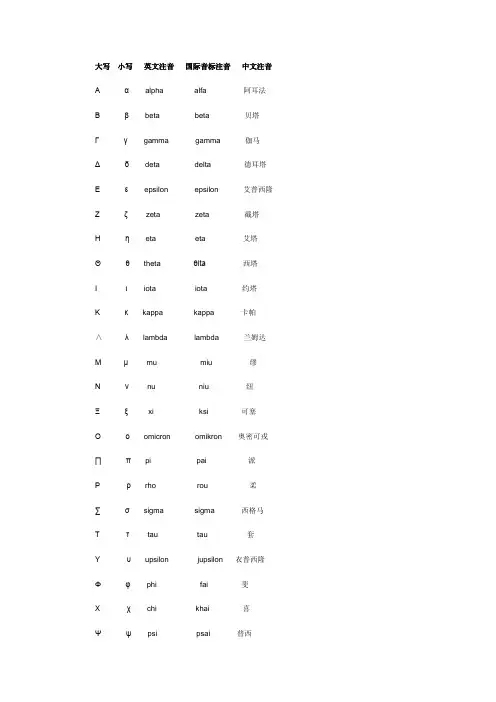
大写小写英文注音国际音标注音中文注音Ααalpha alfa 阿耳法Ββbeta beta 贝塔Γγgamma gamma 伽马Δδdeta delta 德耳塔Εεepsilon epsilon 艾普西隆Ζζzeta zeta 截塔Ηηeta eta 艾塔Θθtheta θita西塔Ιιiota iota 约塔Κκkappa kappa 卡帕∧λlambda lambda 兰姆达Μμmu miu 缪Ννnu niu 纽Ξξxi ksi 可塞Οοomicron omikron 奥密可戎∏πpi pai 派Ρρrho rou 柔∑σsigma sigma 西格马Ττtau tau 套Υυupsilon jupsilon 衣普西隆Φφphi fai 斐Χχchi khai 喜Ψψpsi psai 普西Ωωomega omiga 欧米伽符号表符号含义i -1的平方根f(x) 函数f在自变量x处的值sin(x) 在自变量x处的正弦函数值exp(x) 在自变量x处的指数函数值,常被写作exa^x a的x次方;有理数x由反函数定义ln x exp x 的反函数ax 同a^xlogba 以b为底a的对数;blogba = acos x 在自变量x处余弦函数的值tan x 其值等于sin x/cos xcot x 余切函数的值或cos x/sin xsec x 正割含数的值,其值等于1/cos xcsc x 余割函数的值,其值等于1/sin xasin x y,正弦函数反函数在x处的值,即x = sin y acos x y,余弦函数反函数在x处的值,即x = cos y atan x y,正切函数反函数在x处的值,即x = tan y acot x y,余切函数反函数在x处的值,即x = cot y asec x y,正割函数反函数在x处的值,即x = sec y acsc x y,余割函数反函数在x处的值,即x = csc yθ角度的一个标准符号,不注明均指弧度,尤其用于表示atan x/y,当x、y、z用于表示空间中的点时i, j, k 分别表示x、y、z方向上的单位向量(a, b, c) 以a、b、c为元素的向量(a, b) 以a、b为元素的向量(a, b) a、b向量的点积a?b a、b向量的点积(a?b) a、b向量的点积|v| 向量v的模|x| 数x的绝对值Σ表示求和,通常是某项指数。
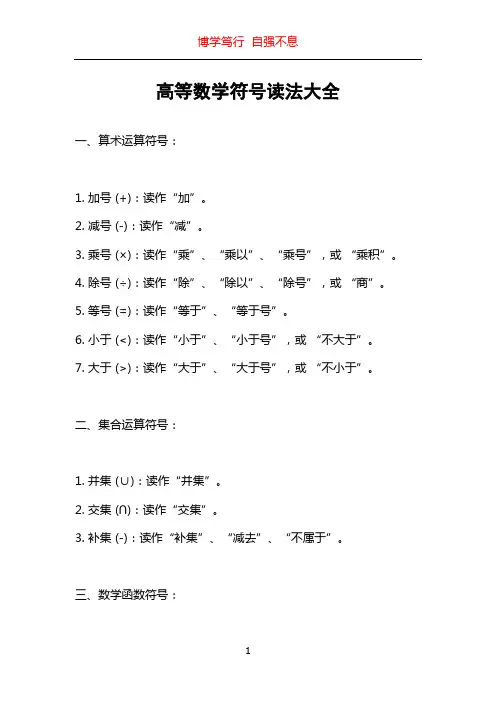
高等数学符号读法大全一、算术运算符号:1. 加号 (+):读作“加”。
2. 减号 (-):读作“减”。
3. 乘号(×):读作“乘”、“乘以”、“乘号”,或“乘积”。
4. 除号(÷):读作“除”、“除以”、“除号”,或“商”。
5. 等号 (=):读作“等于”、“等于号”。
6. 小于 (<):读作“小于”、“小于号”,或“不大于”。
7. 大于 (>):读作“大于”、“大于号”,或“不小于”。
二、集合运算符号:1. 并集(∪):读作“并集”。
2. 交集(∩):读作“交集”。
3. 补集 (-):读作“补集”、“减去”、“不属于”。
三、数学函数符号:1. 求和(∑):读作“求和”、“总和”的符号。
2. 积分(∫):读作“积分”、“定积分”。
3. 极限 (lim):读作“极限”。
4. 求导(∂):读作“求导”、“导数”、“偏微分”。
5. 阶乘 (x!):读作“阶乘”、“x的阶乘”。
四、常用数学符号:1. 无限(∞):读作“无穷大”。
2. 正无穷(+∞):读作“正无穷大”。
3. 负无穷 (-∞):读作“负无穷大”。
4. 接近(∝):读作“接近于”、“趋向于”。
5. 不等于(≠):读作“不等于”、“不等于号”。
6. 大约(≈):读作“大约”、“约等于”。
7. 因果关系(∴):读作“因此”、“所以”。
五、概率与统计符号:1. 平均值 (x̄x̄):读作“x bar”、“x平均值”。
2. 标准差 (x̄):读作“sigma”、“标准差”。
3. 方差 (x̄²):读作“sigma squared”、“方差”。
4. 期望值 (x̄):读作“期望值”、“期望”、“mean”。
5. 随机变量 (x̄):读作“X”、“随机变量”。
6. 概率 (x̄):读作“P”、“概率”。
六、三角函数符号:1. 正弦 (sin):读作“正弦”。
2. 余弦 (cos):读作“余弦”。
3. 正切 (tan):读作“正切”。
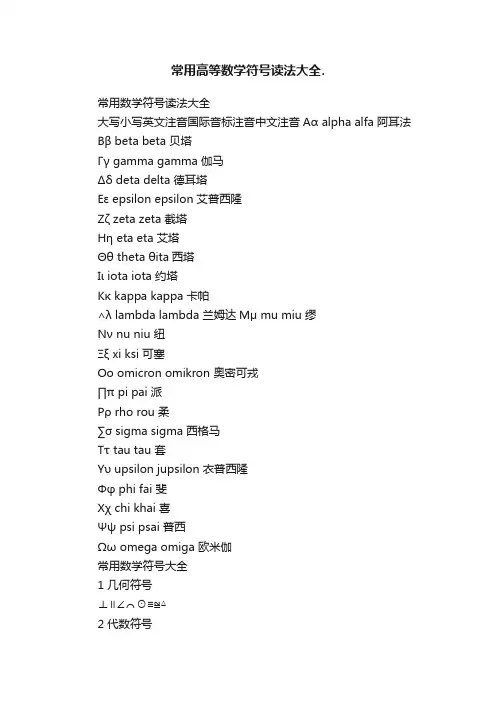
常用高等数学符号读法大全.常用数学符号读法大全大写小写英文注音国际音标注音中文注音Αα alpha alfa 阿耳法Ββ beta beta 贝塔Γγ gamma gamma 伽马Δδ deta delta 德耳塔Εε epsilon epsilon 艾普西隆Ζζ zeta zeta 截塔Ηη eta eta 艾塔Θθ theta θita西塔Ιι iota iota 约塔Κκ kappa kappa 卡帕∧λ lambda lambda 兰姆达Μμ mu miu 缪Νν nu niu 纽Ξξ xi ksi 可塞Οο omicron omikron 奥密可戎∏π pi pai 派Ρρ rho rou 柔∑σ sigma sigma 西格马Ττ tau tau 套Υυ upsilon jupsilon 衣普西隆Φφ phi fai 斐Χχ chi khai 喜Ψψ psi psai 普西Ωω omega omiga 欧米伽常用数学符号大全1 几何符号⊥∥∠⌒⊙≡≌△2 代数符号∝∧∨~∫≠≤≥≈∞∶3运算符号×÷√±4集合符号∪∩∈5特殊符号∑π(圆周率)6推理符号|a| ⊥∽△∠∩∪≠≡±≥≤∈←↑→↓↖↗↘↙∥∧∨&; §①②③④⑤⑥⑦⑧⑨⑩ΓΔΘΛΞΟΠΣΦΧΨΩαβγδεζηθικλμνξοπρστυφχψωⅠ Ⅱ Ⅲ Ⅳ Ⅴ Ⅵ Ⅶ Ⅷ Ⅸ Ⅹ Ⅺ Ⅻⅰ ⅱ ⅲ ⅳ ⅴ ⅵ ⅶ ⅷ ⅸ ⅹ∈∏∑∕√∝∞∟∠∣∥∧∨∩∪∫∮∴∵∶∷∽≈≌≒≠≡≤≥≦≧≮≯⊕⊙⊥⊿⌒℃指数0123:o123上述符号所表示的意义和读法(中英文参照)+ plus 加号;正号- minus 减号;负号± plus or minus 正负号× is multiplied by 乘号÷ is divided by 除号= is equal to 等于号≠ is not equal to 不等于号≡ is equivalent to 全等于号≌ is approximately equal to 约等于≈ is approxima tely equal to 约等于号< is less than 小于号> is more than 大于号≤ is less than or equal to 小于或等于≥ is more than or equal to 大于或等于% per cent 百分之…∞ infinity 无限大号√ (square root 平方根X squared X的平方X cubed X的立方∵ since; because 因为∴ hence 所以∠ angle 角⌒ semicircle 半圆⊙ circle 圆○ circumference 圆周△ triangle 三角形⊥ perpendicular to 垂直于∪ intersection of 并,合集∩ union of 交,通集∫the integral of …的积分∑ (sigma summation of 总和° degree 度′ minute 分〃 second 秒#number …号@ at 单价CNN -- Kezai started receiving professional tennis coaching at the age of eight. Since then his father has worked hard to cover his training costs.Two years on and it all seems to have paid off. In June, a local Chengdu company reached out to Li Chengpeng, Kezai's father, with an offer to sponsor Kezai.Soon after, a professional photographer took pictures of Kezai and his father for advertisements. But the family's happiness was short lived. The company withdrew the sponsorship.Though he says he was never given an explanation, Kezai's father believes it was because of his political activity. The company could not be reached for comment.As a controversial blogger and writer, Li announced his plan to run for office as an independent candidate for China's National People's Congress of Wuhou District, a legislative body at the local level in Sichuan province."You never know the benefit of standing up if you always stay on your knees," Li declared in a campaign statement on his microblog, where he has more than three million regular followers.Through the power of social media, Li's original message was forwarded more than 3,000 times within a few hours on micro-blogging site Sina Weibo, a popular twitter-like service.But such campaigns are rare in China.The Chinese do not choose their own president or premier because all government officials are pre-decided.However, elections are held on the local level, with all candidates approved by the party beforehand.China's electoral law stipulates that every Chinese citizen over 18 has the right to vote and run in local elections. Those, like Li Chengpeng, seeking to become candidates for county or township legislatures must first register and secure confirmation of their candidacy. They must then be nominated as "deputy candidate" by political parties, social organizations or have the signed support of at least 10 registered voters in their constituency.In practice, the government can rule candidates or any of their supporters unqualified and refuse to put them on the ballot, which critics say leaves ample opportunity for manipulation of the results."I know nobody on the ballot sheet. And I don't think my vote will make much difference," a retiree in Beijing said when she was asked to vote for the People's Congress district's last election.In recent months, an unprecedented number of Chinese citizens have declared themselves as independent candidates, according to Li Fan, founder of the World and China Institute that promotes democracy at the local levels.He said many candidates have grievances with the local government and feel they cannot get their voices out."They bid for the position as they think they can draw attention from the public for better solving of the problem," he said."Some local governments did think that their leadership was threatened by these (independent candidates, which is obviously not the case." Li Fan said.Some believe there are concerns among the central government as well. On June 8, state-run media Xinhua quoted the head of the Commission for Legislative Affairs of the NationalPeople's Congress Standing Committee as saying that "there is no such a thing as an 'independent candidate' as it's not recognized by law." All candidates must follow the guidelines laid out by the government.But some do manage to meet the guidelines and run under the banner of an independent. The history of China's independent candidates dates back to 1998, when Yao Lifa, a teacher in Hubei Province, became the first self-described independent candidate elected to the local congress. He lost out when attempting a bid for a second term in 2003.With the government in control of the media and potential candidates subject to government approval, many question whether a truly independent candidate can win. Li Fan says more than 100 people -- many using the internet -- have declared themselves as candidates for upcoming elections for people's congresses across the country."There are no fair and free elections in China," said Li Fan. "Chances are not good for these people leading the wave, but with their appeals, a lot more people will stand out to join in the election. They are the future."No matter what the chances are for Li Chengpeng, he says he is determined. "In China, there is so much unfairness and many choices in life are decided by the others," he explained during an interview with CNN. "I want to make decisions on my own."To achieve his goal, Li Chengpeng has visited more than 100 residents in his constituency, listening to their appeals to work out his campaign plan, trying to secure the government-required support from 10 registered voters. He also continues to speak out on his blog.Li Chengpeng is not sure whether his name will appear on the ballot in September, when the election process officially begins, but he tries to be optimistic. "I'm confident. If I'm not confident, how can I convince my supporters?" he said.Li Chengpeng is not so confident about securing another tennis sponsorship for his son, if his political activities indeed caused him to lose the first one. He says he plans to fight on as an independent -- and he has his son's support.。
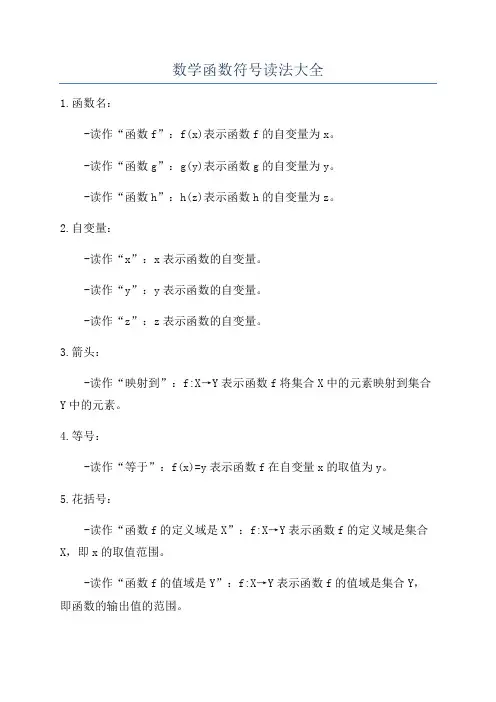
数学函数符号读法大全1.函数名:-读作“函数f”:f(x)表示函数f的自变量为x。
-读作“函数g”:g(y)表示函数g的自变量为y。
-读作“函数h”:h(z)表示函数h的自变量为z。
2.自变量:-读作“x”:x表示函数的自变量。
-读作“y”:y表示函数的自变量。
-读作“z”:z表示函数的自变量。
3.箭头:-读作“映射到”:f:X→Y表示函数f将集合X中的元素映射到集合Y中的元素。
4.等号:-读作“等于”:f(x)=y表示函数f在自变量x的取值为y。
5.花括号:-读作“函数f的定义域是X”:f:X→Y表示函数f的定义域是集合X,即x的取值范围。
-读作“函数f的值域是Y”:f:X→Y表示函数f的值域是集合Y,即函数的输出值的范围。
6.圆括号:-读作“f的自变量为x”:f(x)表示函数f的自变量为x。
-读作“g的自变量为y”:g(y)表示函数g的自变量为y。
-读作“h的自变量为z”:h(z)表示函数h的自变量为z。
7.其他常见符号:-读作“f和g的复合函数”:(f∘g)(x)表示函数f和g的复合函数。
- 读作“f 在 x 处的极限是l”:lim(x→a) f(x) = l 表示函数 f 在 x 趋近于 a 时的极限是 l。
-读作“函数f的导数是f'”:f'(x)表示函数f的导数。
- 读作“函数 f 的积分是F”:∫ f(x) dx = F(x) 表示函数 f 的积分是 F。
- 读作“函数 f 在 x 处的微分是df”:df = f'(x) dx 表示函数f 在 x 处的微分是 df。
-读作“方程f(x)=0的解是x”:f(x)=0表示方程f(x)的解是x。
- 读作“函数 f 的最大值是M”:max f(x) = M 表示函数 f 的最大值是 M。
- 读作“函数 g 的最小值是m”:min g(x) = m 表示函数 g 的最小值是 m。
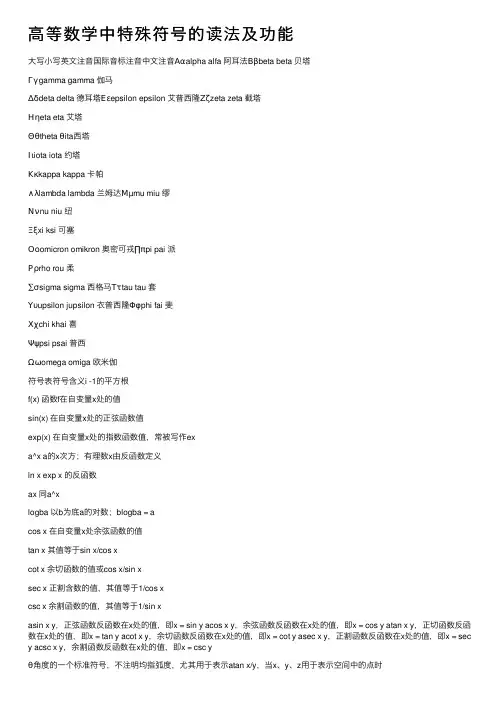
⾼等数学中特殊符号的读法及功能⼤写⼩写英⽂注⾳国际⾳标注⾳中⽂注⾳Ααalpha alfa 阿⽿法Ββbeta beta 贝塔Γγgamma gamma 伽马Δδdeta delta 德⽿塔Εεepsilon epsilon 艾普西隆Ζζzeta zeta 截塔Ηηeta eta 艾塔Θθtheta θita西塔Ιιiota iota 约塔Κκkappa kappa 卡帕∧λlambda lambda 兰姆达Μµmu miu 缪Ννnu niu 纽Ξξxi ksi 可塞Οοomicron omikron 奥密可戎∏πpi pai 派Ρρrho rou 柔∑σsigma sigma 西格马Ττtau tau 套Υυupsilon jupsilon ⾐普西隆Φφphi fai 斐Χχchi khai 喜Ψψpsi psai 普西Ωωomega omiga 欧⽶伽符号表符号含义i -1的平⽅根f(x) 函数f在⾃变量x处的值sin(x) 在⾃变量x处的正弦函数值exp(x) 在⾃变量x处的指数函数值,常被写作exa^x a的x次⽅;有理数x由反函数定义ln x exp x 的反函数ax 同a^xlogba 以b为底a的对数;blogba = acos x 在⾃变量x处余弦函数的值tan x 其值等于sin x/cos xcot x 余切函数的值或cos x/sin xsec x 正割含数的值,其值等于1/cos xcsc x 余割函数的值,其值等于1/sin xasin x y,正弦函数反函数在x处的值,即x = sin y acos x y,余弦函数反函数在x处的值,即x = cos y atan x y,正切函数反函数在x处的值,即x = tan y acot x y,余切函数反函数在x处的值,即x = cot y asec x y,正割函数反函数在x处的值,即x = sec y acsc x y,余割函数反函数在x处的值,即x = csc yθ⾓度的⼀个标准符号,不注明均指弧度,尤其⽤于表⽰atan x/y,当x、y、z⽤于表⽰空间中的点时i, j, k 分别表⽰x、y、z⽅向上的单位向量(a, b, c) 以a、b、c为元素的向量(a, b) 以a、b为元素的向量(a, b) a、b向量的点积a?b a、b向量的点积(a?b) a、b向量的点积|v| 向量v的模|x| 数x的绝对值Σ表⽰求和,通常是某项指数。
常用数学符号读法大全大写小写英文注音国际音标注音中文注音Ααalpha alfa 阿耳法Ββbeta beta 贝塔Γγgamma gamma 伽马Γδdeta delta 德耳塔Δεepsilon epsilon 艾普西隆Εδzeta zeta 截塔Ζεeta eta 艾塔Θζtheta ζita西塔Ηηiota iota 约塔Θθkappa kappa 卡帕ⅸιlambda lambda 兰姆达Μκmu miu 缪Νλnu niu 纽Ξμxi ksi 可塞Ονomicron omikron 奥密可戎∏πpi pai 派Ρξrho rou 柔∑ζsigma sigma 西格马Τηtau tau 套Υυupsilon jupsilon 衣普西隆Φθphi fai 斐Φχchi khai 喜Χψpsi psai 普西Ψωomega omiga 欧米伽常用数学符号大全1 几何符号ⅷⅶ↋ↆↄ△2 代数符号ⅴⅸⅹ~ⅼↅↇↈↃⅵↀ3运算符号×÷ⅳ±4集合符号ⅻⅺⅰ5特殊符号ⅲπ(圆周率)6推理符号|a| ↂ△ⅶⅺⅻↅↆ±ↈↇⅰⅬⅭⅮⅯ↖↗↘↙ⅷⅸⅹ&; §←↑→↓↔↕↖↗ΓΔΘΛΞΟΠΣΦΧΨΩαβγδεδεζηθικλμνπξζηυθχψωⅠ Ⅱ Ⅲ Ⅳ Ⅴ Ⅵ Ⅶ Ⅷ Ⅸ Ⅹ Ⅺ Ⅻⅰ ⅱ ⅲ ⅳ ⅴ ⅵ ⅶ ⅷ ⅸ ⅹⅰⅱⅲ↚ⅳⅴⅵ↛ⅶ↜ⅷⅸⅹⅺⅻⅼⅽⅾⅿↀↁↂↃↄ↝ↅↆↇↈ↞↟↉↊⊕↋↠℃指数0123:o123上述符号所表示的意义和读法(中英文参照)+ plus 加号;正号- minus 减号;负号± plus or minus 正负号× is multiplied by 乘号÷ is divided by 除号= is equal to 等于号ↅ is not equal to 不等于号ↆ is equivalent to 全等于号ↄ is approximately equal to 约等于Ↄ is approximately equal to 约等于号< is less than 小于号> is more than 大于号ↇ is less than or equal to 小于或等于ↈ is more than or equal to 大于或等于% per cent 百分之…ⅵ infinity 无限大号ⅳ (square) root 平方根X squared X的平方X cubed X的立方ⅿ since; because 因为ⅾ hence 所以ⅶ angle 角 semicircle 半圆↋ circle 圆○ circumference 圆周△ triangle 三角形 perpendicular to 垂直于ⅻ intersection of 并,合集ⅺ union of 交,通集ⅼthe integral of …的积分ⅲ (sigma) summation of 总和° degree 度′ minute 分〃 second 秒#number …号@ at 单价CNN) -- Kezai started receiving professional tennis coaching at the age of eight. Since then his father has worked hard to cover his training costs.Two years on and it all seems to have paid off. In June, a local Chengdu company reached out to Li Chengpeng, Kezai's father, with an offer to sponsor Kezai.Soon after, a professional photographer took pictures of Kezai and his father for advertisements. But the family's happiness was short lived. The company withdrew the sponsorship.Though he says he was never given an explanation, Kezai's father believes it was because of his political activity. The company could not be reached for comment.As a controversial blogger and writer, Li announced his plan to run for office as an independent candidate for China's National People's Congress of Wuhou District, a legislative body at the local level in Sichuan province."You never know the benefit of standing up if you always stay on your knees," Li declared in a campaign statement on his microblog, where he has more than three million regular followers. Through the power of social media, Li's original message was forwarded more than 3,000 times within a few hours on micro-blogging site Sina Weibo, a popular twitter-like service.But such campaigns are rare in China.The Chinese do not choose their own president or premier because all government officials are pre-decided.However, elections are held on the local level, with all candidates approved by the party beforehand.China's electoral law stipulates that every Chinese citizen over 18 has the right to vote and run in local elections. Those, like Li Chengpeng, seeking to become candidates for county or township legislatures must first register and secure confirmation of their candidacy. They must then be nominated as "deputy candidate" by political parties, social organizations or have the signed support of at least 10 registered voters in their constituency.In practice, the government can rule candidates or any of their supporters unqualified and refuse to put them on the ballot, which critics say leaves ample opportunity for manipulation of the results."I know nobody on the ballot sheet. And I don't think my vote will make much difference," a retiree in Beijing said when she was asked to vote for the People's Congress district's last election.In recent months, an unprecedented number of Chinese citizens have declared themselves as independent candidates, according to Li Fan, founder of the World and China Institute that promotes democracy at the local levels.He said many candidates have grievances with the local government and feel they cannot get their voices out."They bid for the position as they think they can draw attention from the public for better solving of the problem," he said."Some local governments did think that their leadership was threatened by these (independent candidates), which is obviously not the case." Li Fan said.Some believe there are concerns among the central government as well. On June 8, state-run media Xinhua quoted the head of the Commission for Legislative Affairs of the National People's Congress Standing Committee as saying that "there is no such a thing as an'independent candidate' as it's not recognized by law." All candidates must follow the guidelines laid out by the government.But some do manage to meet the guidelines and run under the banner of an independent. The history of China's independent candidates dates back to 1998, when Yao Lifa, a teacher inHubei Province, became the first self-described independent candidate elected to the local congress. He lost out when attempting a bid for a second term in 2003.With the government in control of the media and potential candidates subject to government approval, many question whether a truly independent candidate can win. Li Fan says more than 100 people -- many using the internet -- have declared themselves as candidates for upcoming elections for people's congresses across the country."There are no fair and free elections in China," said Li Fan. "Chances are not good for these people leading the wave, but with their appeals, a lot more people will stand out to join in the election. They are the future."No matter what the chances are for Li Chengpeng, he says he is determined. "In China, there is so much unfairness and many choices in life are decided by the others," he explained during an interview with CNN. "I want to make decisions on my own."To achieve his goal, Li Chengpeng has visited more than 100 residents in his constituency, listening to their appeals to work out his campaign plan, trying to secure thegovernment-required support from 10 registered voters. He also continues to speak out on his blog.Li Chengpeng is not sure whether his name will appear on the ballot in September, when the election process officially begins, but he tries to be optimistic. "I'm confident. If I'm not confident, how can I convince my supporters?" he said.Li Chengpeng is not so confident about securing another tennis sponsorship for his son, if his political activities indeed caused him to lose the first one. He says he plans to fight on as an independent -- and he has his son's support.。
高等数学所有符号的写法与读法 ̄连字符' 省略号;所有格符号—破折号‘’单引号“”双引号( ) 圆括号[ ] 方括号{}《》法文引号;书名号... 省略号¨双点号" 同上‖双线号/斜线号&=~代字号§ ; 分节号→箭号;参见号+加号;正号-减号;负号±正负号×乘号÷除号=等于号≠不等于号≡全等于号≌等于或约等于号≈约等于号<小于号>大于号≮不小于号≯不大于号≤小于或等于号≥大于或等于号%百分之…‰千分之…∞无限大号∝与…成比例√ () 平方根∵ ; 因为∴所以∷ , () 等于,成比例∠角⌒半圆⊙圆○圆周π圆周率△三角形⊥垂直于∪并,合集∩交,通集∫…的积分∑ () 总和°度′分〃秒#…号℃摄氏度@单价x'是x (比如转置矩阵)x"是x常用数学符号读法大全以及主要数学符号含义-转载数学符号:(1)数量符号:如:i,2,a,x,自然对数底e,圆周率π。
(2)运算符号:如加号(+),减号(-),乘号(×或·),除号(÷或/),两个集合的并集(∪),交集(∩),根号(√),对数(,,),比(:),微分(),积分(∫)等。
(3)关系符号:如“=”是等号,“≈”是近似符号,“≠”是不等号,“>”是大于符号,“<”是小于符号,“→”表示变量变化的趋势,“∽”是相似符号,“≌”是全等号,“∥”是平行符号,“⊥”是垂直符号,“∝”是反比例符号,“∈”是属于符号,“C”或“C下面加一横”是“包含”符号等。
(4)结合符号:如圆括号“()”方括号“[]”,花括号“{}”括线“—”(5)性质符号:如正号“+”,负号“-”,绝对值符号“‖”(6)省略符号:如三角形(△),正弦(),余弦(),x的函数(f(x)),极限(),因为(∵),所以(∴),总和(∑),连乘(∏),从n个元素中每次取出r个元素所有不同的组合数(C(r)(n) ),幂(A,,,x^n),阶乘(!)等。
一些数学符号的读音电工电子2009-09-09 07:53:10 阅读1604 评论3 字号:大中小1 Ααalpha a:lf 阿尔法角度;系数2 Ββbeta bet 贝塔磁通系数;角度;系数3 Γγgamma ga:m 伽马电导系数(小写)4 Δδdelta delt 德尔塔变动;密度;屈光度5 Εεepsilon ep`silon 伊普西龙对数之基数6 Ζζzeta zat 截塔系数;方位角;阻抗;相对粘度;原子序数7 Ηηeta eit 艾塔磁滞系数;效率(小写)8 Θθthet θit西塔温度;相位角9 Ιιiot aiot 约塔微小,一点儿10 Κκkappa kap 卡帕介质常数11 ∧λlambda lambd 兰布达波长(小写);体积12 Μμmu mju 缪磁导系数;微(千分之一);放大因数(小写)13 Ννnu nju 纽磁阻系数14 Ξξxi ksi 克西15 Οοomicron omik`ron 奥密克戎16 ∏πpi pai 派圆周率=圆周÷直径=3.141617 Ρρrho rou 肉电阻系数(小写)18 ∑σsigma `sigma 西格马总和(大写),表面密度;跨导(小写)19 Ττtau tau 套时间常数20 Υυupsilon jup`silon 宇普西龙位移21 Φφphi fai 佛爱磁通;角22 Χχchi phai 西23 Ψψpsi psai 普西角速;介质电通量(静电力线);角24 Ωωomega o`miga 欧米伽欧姆(大写);角速(小写);角希腊字母读法Αα:阿尔法AlphaΒβ:贝塔BetaΓγ:伽玛GammaΔδ:德尔塔DelteΕε:艾普西龙Epsilonζ:捷塔ZetaΖη:依塔EtaΘθ:西塔ThetaΙι:艾欧塔IotaΚκ:喀帕Kappa∧λ:拉姆达LambdaΜμ:缪MuΝν:拗NuΞξ:克西XiΟο:欧麦克轮Omicron∏π:派PiΡρ:柔Rho∑σ:西格玛SigmaΤτ:套TauΥυ:宇普西龙UpsilonΦφ:fai PhiΧχ:器ChiΨψ:普赛PsiΩω:欧米伽Omega希腊字母怎么打打开Office文档之后,在你需要输入希腊字母的时候,先将输入法切换为英文状态,然后同时按下三个键Ctrl+Shift+Q ,工具栏上的“字体”就会发生变化此刻,你再对照下表输入a,b,c……即可得到您想要的希腊字母。
高数数学符号的读法一、运算符号1. “+”加号,可读作“加上”。
2. “-”减号,可读作“减”。
3. “×”乘号,可读作“乘”或“乘以”。
4. “÷”除号,可读作“除以”。
5. “=”等于号,可读作“等于”,另外,较大量的等于可以用“囿于篇幅原因,此处省略XXX 个字”代替。
6. “>”大于号,可读作“大于”。
7. “<”小于号,可读作“小于”。
8. “≥”大于或等于号,可读作“大于或等于”。
9. “≤”小于或等于号,可读作“小于或等于”。
10. “≠”不等于号,可读作“不等于”。
二、代数符号1. “n”表示正整数集。
2. “N+”表示正整数集内的所有正数。
3. “N”表示所有自然数。
4. “Z”表示整数集。
5. “Q”表示有理数集。
6. “R”表示实数集。
7. “0”表示零或常数。
8. “+”右上角小数字,代表幂,比如“x2”可读作“x的平方”。
9. “i”表示虚数单位。
10. “∞”表示无穷大。
三、函数符号1. “f(x)”,表示函数名,读作“f 括号x”,其中x为自变量。
2. “sin(x)”,正弦函数,读作“正弦括号x”。
3. “cos(x)”,余弦函数,读作“余弦括号x”。
4. “tan(x)”,正切函数,读作“正切括号x”。
5. “ln(x)”,自然对数函数,读作“自然对数括号x”。
6. “log(x)”,对数函数,读作“对数括号x”。
7. “π”,圆周率,读作“派”。
8. “e”,自然对数的底数,读作“e”。
9. “ρ”,总体密度函数的泊松分布参数,读作“rho”。
10. “σ”,标准差或均方差的正态分布参数,读作“sigma”。
四、集合符号1. “A”,“B”,“C”等大写字母表示集合。
例如,“A={1,2,3}”可以读作集合A包含元素1,2,3。
2. “a”,“b”,“c”等小写字母表示元素。
例如,“a∈A”可以读作元素a属于集合A。
3. “∈”表示集合的并运算。
高等数学常用数学符号读法大全以及主要数学符号含义-转载大写小写英文注音国际音标注音中文注音Α α alpha alfa阿耳法Β β beta beta贝塔Γ γ gamma gamma伽马Γ δ deta delta德耳塔Δ ε epsilon epsilon艾普西隆Ε δ zeta zeta截塔Ζ ε eta eta艾塔Θ ζ theta ζita西塔Η η iota iota约塔Κ θ kappa kappa卡帕∧ι lambda lambda兰姆达Μ κmu miu缪Ν λ nu niu纽Ξ μ xi ksi可塞Ο ν omicro n omikron奥密可戎∏ π pi pai派Ρ ξ rho rou柔∑ ζ sigma sigma西格马Τ η tau tau套Υ υ upsilon jupsilon衣普西隆Φ θ phi fai斐Φ χ chi khai喜Χ ψ psi psai普西Ψ ω omega omiga欧米伽数学符号:(1)数量符号:如:i,2+i,a,x,自然对数底e,圆周率π。
(2)运算符号:如加号(+),减号(-),乘号(×或·),除号(÷或/),两个集合的并集(∪),交集(∩),根号(√),对数(log,lg,ln),比(:),微分(dx),积分(∫)等。
(3)关系符号:如“=”是等号,“≈”是近似符号,“≠”是不等号,“>”是大于符号,“<”是小于符号,“→ ”表示变量变化的趋势,“∽”是相似符号,“≌”是全等号,“∥”是平行符号,“⊥”是垂直符号,“∝”是反比例符号,“∈”是属于符号,“C”或“C下面加一横”是“包含”符号等。
(4)结合符号:如圆括号“()”方括号“[]”,花括号“{}”括线“—”(5)性质符号:如正号“+”,负号“-”,绝对值符号“‖”(6)省略符号:如三角形(△),正弦(sin),余弦(cos),x的函数(f(x)),极限(lim),因为(∵),所以(∴),总和(∑),连乘(∏),从n个元素中每次取出r个元素所有不同的组合数(C(r)(n) ),幂(A,Ac,Aq,x^n),阶乘(!)等。
大写小写英文注音国际音标注音中文注音Ααalpha alfa 阿耳法Ββbeta beta 贝塔
Γγgamma gamma 伽马
Δδdeta delta 德耳塔Εεepsilon epsilon 艾普西隆Ζζzeta zeta 截塔
Ηηeta eta 艾塔
Θθtheta θita西塔
Ιιiota iota 约塔
Κκkappa kappa 卡帕
∧λlambda lambda 兰姆达
Μμmu miu 缪
Ννnu niu 纽
Ξξxi ksi 可塞
Οοomicron omikron 奥密可戎∏πpi pai 派
Ρρrho rou 柔
∑σsigma sigma 西格马
Ττtau tau 套
Υυupsilon jupsilon 衣普西隆
Φφphi fai 斐
Χχchi khai 喜
Ψψpsi psai 普西
Ωωomega omiga 欧米伽
符号表符号含义i -1的平方根
f(x) 函数f在自变量x处的值
sin(x) 在自变量x处的正弦函数值
exp(x) 在自变量x处的指数函数值,常被写作ex
a^x a的x次方;有理数x由反函数定义
ln x exp x 的反函数
ax 同a^x
logba 以b为底a的对数;blogba = a
cos x 在自变量x处余弦函数的值
tan x 其值等于sin x/cos x
cot x 余切函数的值或cos x/sin x
sec x 正割含数的值,其值等于1/cos x
csc x 余割函数的值,其值等于1/sin x
asin x y,正弦函数反函数在x处的值,即x = sin y acos x y,余弦函数反函数在x处的值,即x = cos y atan x y,正切函数反函数在x处的值,即x = tan y acot x y,余切函数反函数在x处的值,即x = cot y asec x y,正割函数反函数在x处的值,即x = sec y acsc x y,余割函数反函数在x处的值,即x = csc y
θ角度的一个标准符号,不注明均指弧度,尤其用于表示atan x/y,当x、y、z用于表示空间中的点时
i, j, k 分别表示x、y、z方向上的单位向量
(a, b, c) 以a、b、c为元素的向量
(a, b) 以a、b为元素的向量
(a, b) a、b向量的点积
a?b a、b向量的点积
(a?b) a、b向量的点积
|v| 向量v的模
|x| 数x的绝对值
Σ表示求和,通常是某项指数。
下边界值写在其下部,上边界值写在其上部。
如j从1到100
符号含义
的和可以表示成:。
这表示 1 + 2 + … + n
M 表示一个矩阵或数列或其它
|v> 列向量,即元素被写成列或可被看成k×1阶矩阵的向量
<v| 被写成行或可被看成从1×k阶矩阵的向量
dx 变量x的一个无穷小变化,dy, dz, dr等类似
ds 长度的微小变化
ρ变量(x2 + y2 + z2)1/2 或球面坐标系中到原点的距离
r 变量(x2 + y2)1/2 或三维空间或极坐标中到z轴的距离
|M| 矩阵M的行列式,其值是矩阵的行和列决定的平行区域的面积或体积||M|| 矩阵M的行列式的值,为一个面积、体积或超体积
det M M的行列式
M-1 矩阵M的逆矩阵
v×w 向量v和w的向量积或叉积
θvw向量v和w之间的夹角
A?B×C 标量三重积,以A、B、C为列的矩阵的行列式
uw 在向量w方向上的单位向量,即w/|w|
df 函数f的微小变化,足够小以至适合于所有相关函数的线性近似
df/dx f关于x的导数,同时也是f的线性近似斜率
f ' 函数f关于相应自变量的导数,自变量通常为x
f/x y、z固定时f关于x的偏导数。
通常f关于某变量q的偏导数为当其它几个变量固定时df与dq的比值。
任何可能导致变量混淆的地方都应明确地表述
(?f/?x)|r,z 保持r和z不变时,f关于x的偏导数
grad f 元素分别为f关于x、y、z偏导数[(?f/?x), (?f/?y), (?f/?z)] 或(?f/?x)i + (?f/?y)j + (?f/?z)k; 的向量场,称为f的梯度
向量算子(?/?x)i + (?/?x)j + (?/?x)k, 读作"del"
f f的梯度;它和uw 的点积为f在w方向上的方向导数
w 向量场w的散度,为向量算子? 同向量w的点积, 或(?wx /?x) + (?wy /?y) + (?wz /?z) curl w 向量算子? 同向量w 的叉积
×w w的旋度,其元素为[(?fz /?y) - (?fy /?z), (?fx /?z) - (?fz /?x), (?fy /?x) - (?fx /?y)] 拉普拉斯微分算子:(?2/?x2) + (?/?y2) + (?/?z2)
f "(x) f关于x的二阶导数,f '(x)的导数
d2f/dx2 f关于x的二阶导数
f(2)(x) 同样也是f关于x的二阶导数
符号含义
f(k)(x) f关于x的第k阶导数,f(k-1) (x)的导数
T 曲线切线方向上的单位向量,如果曲线可以描述成r(t), 则T = (dr/dt)/|dr/dt|
ds 沿曲线方向距离的导数
κ曲线的曲率,单位切线向量相对曲线距离的导数的值:|dT/ds|
N dT/ds投影方向单位向量,垂直于T
B 平面T和N的单位法向量,即曲率的平面
τ曲线的扭率:|dB/ds|
g 重力常数
F 力学中力的标准符号
k 弹簧的弹簧常数
pi 第i个物体的动量
H 物理系统的哈密尔敦函数,即位置和动量表示的能量
{Q, H} Q, H的泊松括号
以一个关于x的函数的形式表达的f(x)的积分
函数f 从a到b的定积分。
当f是正的且 a < b 时表示由x轴和直线y = a, y = b 及在这些直
线之间的函数曲线所围起来图形的面积
L(d) 相等子区间大小为d,每个子区间左端点的值为f的黎曼和
R(d) 相等子区间大小为d,每个子区间右端点的值为f的黎曼和
M(d) 相等子区间大小为d,每个子区间上的最大值为f的黎曼和
m(d) 相等子区间大小为d,每个子区间上的最小值为f的黎曼和
+:plus(positive正的)
-:minus(negative负的)
*:multiplied by
÷:divided by
=:be equal to
≈:be approximately equal to
():round brackets(parenthess)
[]:square brackets
{}:braces
∵:because
∴:therefore
≤:less than or equal to
≥:greater than or equal to
∞:infinity
LOGnX:logx to the base n
xn:the nth power of x
f(x):the function of x
dx:diffrencial of x
x+y:x plus y
(a+b):bracket a plus b bracket closed
a=b:a equals b
a≠b:a isn't equal to b
a>b:a is greater than b
a>>b:a is much greater than b
a≥b: a is greater than or equal to b
x→∞:x approches infinity
x2:x square
x3:x cube
√ ̄x:the square root of x
3√ ̄x:the cube root of x
3‰:three peimill
n∑i=1xi:the summation of x where x goes from 1to n
n∏i=1xi:the product of x sub i where igoes from 1to n ∫ab:integral betweens a and b。